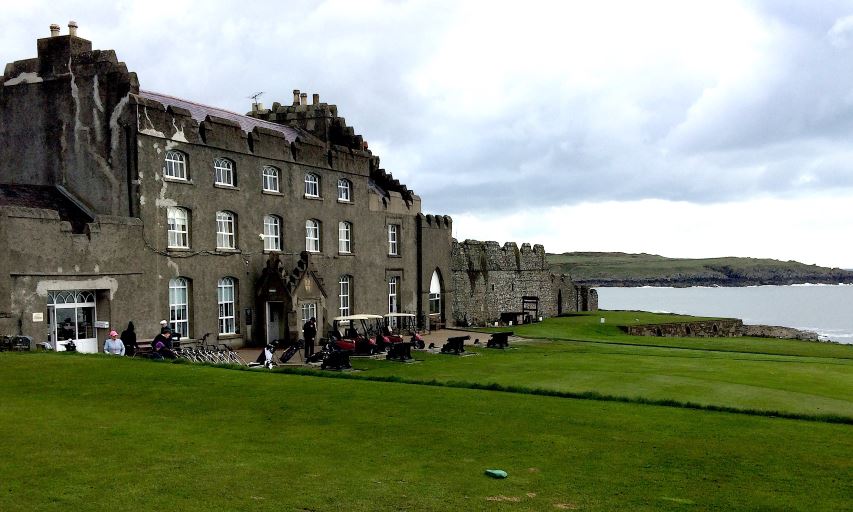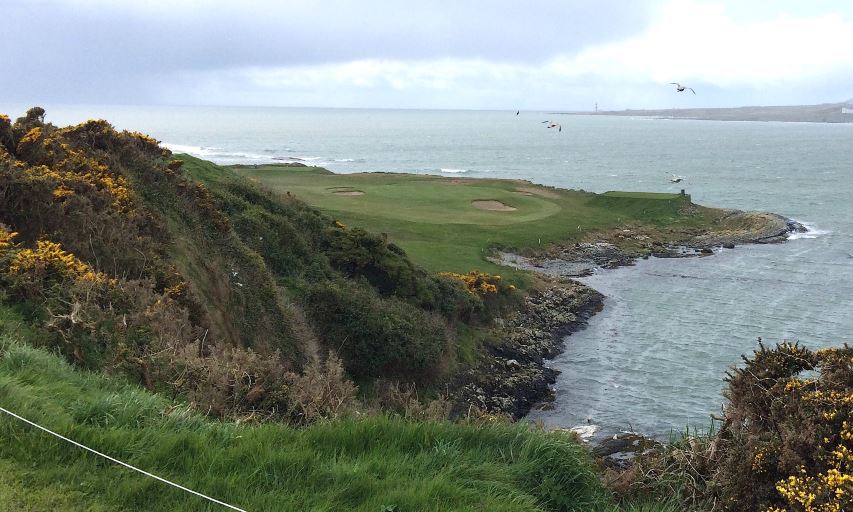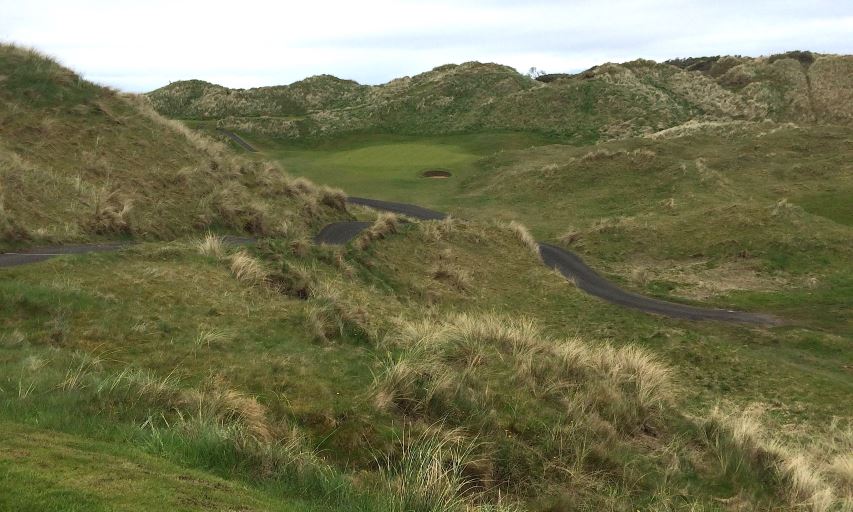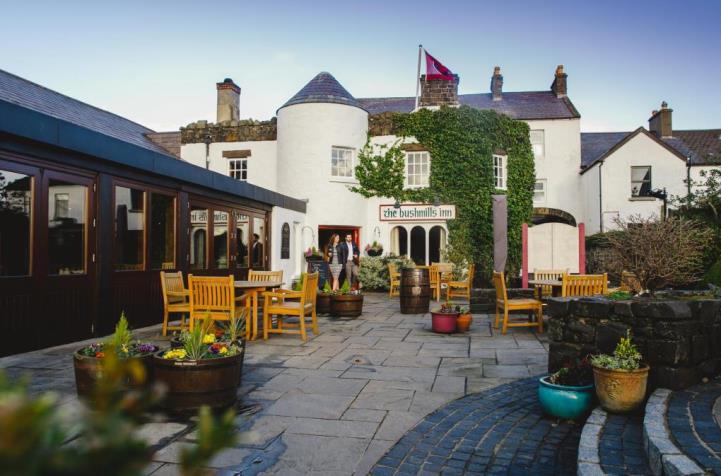Golf In Ireland, Part 2: Ireland's Golf History As Much Fun As Game Itself
- Details
- Category: Inside Golf
- Published: 2018-05-26

Touted As The Oldest Clubhouse In The World, The Castle That Serves That Purpose At The Ardglass Golf Club Was Constructed in 1405. And, If You'd Like To Argue That Point, The Cannons Sitting In Front Of The Building May Help Change Your Mind. (Photo/Gord Montgomery)
Golf’s history is long and interesting and nowhere is that more apparent than in Northern Ireland, where some of the best links courses were designed back in the 1800s, and in places some spots, castles serve as modern-day clubhouses.
NORTHERN IRELAND (Gord Montgomery/iG) — If you’re looking to make your foursome friends green with envy, simply utter this six-word phrase the next time you’re about to tee off: “I’m going to Ireland to golf!”
Knowing you’re heading to the Emerald Isle they’ll most certainly be jealous. After all, what’s said about Irish golf in the phrase, “People go to Scotland to golf because they have to. They go to Ireland to golf because they want to,” is enough of a poke in the ribs to make anyone envious of what awaits you on this epic golfing journey.
What one has to remember about golf in Ireland, while relatively simple, it’s sometimes hard to understand — this sort of golf game is diametrically opposite of what we are used to in North America.
You see, not all well struck shots on these fascinating links courses end up as “good” shots. In other words, they’re good until they’re bad. Confused? Don’t be. You see, where the ball lands here is not where it’s going to end up. It can roll a long, long way before coming to rest, seemingly often in the deep, tangly rough. There, your projectile can sit up like a baseball in T-ball, waiting for you to smack the daylights out of it. Instead, you tend to cut underneath the ball and thus advance it only a few feet at best. And that’s if you’re lucky.
But whatever fate befalls you, good or bad, birdie or double bogey, on these wonders of the golfing world, it’s to be enjoyed. After all, this is the way golf was way back when and the way everyone should play it at least a few times in their life.
What you need here, more than anything, is imagination and a good short game comprised of bump-and-run shots. Those “grounders” also help when the wind is gusting in off the water. Plus, these are fairways where you can use your putter from 50 or 60 yards out before ever getting to the actual putting surface, as long as there aren’t any of those darned pot bunkers in the way!
Golf’s history is long and interesting and nowhere is that more apparent than in Northern Ireland, where some of the best links courses were designed back in the 1800s, and in places some spots, castles serve as modern-day clubhouses. So if you get to make this journey it’s no wonder your friends will be overcome with envy, not only for the golf you’re play but the history that unfolds in front of you, on this trip of a lifetime.
Ardglass Golf Club
Even before you step onto the historic fairways of this cliffside course, you jaw is bouncing off the ground after seeing the clubhouse for the first time. It’s referred to as “The Oldest Clubhouse in the World,” having been constructed seaside in 1405. Yes, it is a castle, and yes, it is a clubhouse, and yes, it is amazing!
As for the golf course, this is one layout where you simplify y can’t take enough photos. It’s a stunning seaside/cliffside links layout that came into being under the hand of Rev. Thomas MacAfee as a seven-holer back in 1896 and played to less than 1,000 total yards. Now though, this creation covers 6,300 yards at its longest … meaning that shots here must be accurately struck, not struck with a viciousness.
There isn’t a weak hole on this walk and this track rates as a must-play, if only for teeing off in front of that magnificent castle/clubhouse. And don’t be fooled by the “short” yardage from the tips. There’s a reason for that.
“It’s a clifftop links that you don’t see too many of,” Adam Cathers, one of the club’s assistant professionals, explained. “The wind plays a big factor on our golf course. We’re only6,300 yards but when the wind blows, that’s our defence.”

The Second Par 3 On The Back Nine Of The Ardglass GC Is Spectacularly Scenic, And At 205 Yards From The Tips, Requires A Huge Amount Of Courage To Aim Your Tee Shot Out Over The Water To Let The Wind Bring It Back To Solid Ground. (Photo/Gord Montgomery)
As for advice on how to play this gorgeous piece of property, it’s part common sense and part Irish golfing ideas that rolled off Cathers’ tongue. “Keep the ball low and land it short of the greens,” which sounds simple but at times can be a difficult chore. That difficulty is especially noticeable on the 12th, a downhill 205-yard beauty of a par-3 where if the breeze is up, as it was when we played, your tee shot has to be aimed out over the water, which can be a wee bit unnerving in itself. A magnificent hole where par feels like a birdie!
But remember, even if you don't play this course the exact way the recommendations suggest, the photo ops out here are spectacular — even if your game isn’t.
Royal Portrush - Dunluce Links
Viewed by most, if not all golf aficionados as one of the best and most challenging links courses in the world Royal Portrush is the only club in Ireland to have hosted the Open Championship and it’s about to do so again in 2019. First opened in 1888 and known as the County Club, it too was a 9-hole loop but the next year it became a full 18 holes and obtained its Royal status in 1892. It’s name was then changed to Royal Portrush in 1895.
In speaking about his course, the Dunce Links, that will again play host to the 148th Open, Gary McNeill, the club’s head professional, noted the most noticeable characteristic, besides the firmness of the turf is “There are no trees out there!”

The Head Pro At Royal Portrush Dunluce Links, Where The 2019 Open Will Be Held For The Second Time, Explained That No Matter How Much Rain Falls On His Course It Runs Right Though The Sandy Soil, Meaning There Is Never A Challenge With Standing Water. Wind And The Rough Are Another Matter Altogether Though. (Photo/Gord Montgomery)
McNeill explained the term “links” comes from the fact the area where such courses sit was the “link between the sea and the arable land. Before golf was played, they shot rabbits and walked on this land that no matter how much rain fell, it drained right through so we have these firm conditions all year round.”
One key thing about Royal Portrush is its layout. It’s wild, wooly and interestingly enough, no two back-to-back holes run in the same direction. Given the winds out here, that in itself makes for an intriguing day on the links, especially given how penal the rough at this particular track is.
“In many cases, when the rough comes up, the shortest route back to the fairway is the best idea,” McNeill cautioned about being perhaps not being too aggressive with a recovery shot.
While this is another course with great visuals at almost every turn, the names of the holes are also something to ponder. Take for example the second hole, known as Giant’s Grave; the ninth which is referred to as Tavern; the 13th, Feather Bed and then Nos. 16 and 17 of the finishing stretch, Calamity Corner and Purgatory respectively.
All told, Royal Portrush plays to a wee bit over 7,300 yards which you don’t even want to think about playing unless you carry a very, very low handicap. From the Medal Tees this track is still a test at 6,700 yards while the Society, or Green Tees, play out to 6,300 yards.
And be advised before you set your sights on establishing a new course record. That mark is presently held by some guy named Rory McIlroy who carded a 65 — even though his actual score was 61 because he was a plus-4 handicap.
If you’re going to try out a British Open test, be aware that the weather can change in an instant here so have your rain gear, your cold weather gear and nerves of steel close at hand to take on one of the most talked about, and highest ranked golf courses in Ireland.
Port Stewart - Strand Course
As a golf writer I’ve had the opportunity to play some pretty neat tracks over the years, where often the presentation of holes is as good as the playability itself. Off the top of my head though, I’d be hard-pressed to think of one that made more of an impact over its opening nine holes than the beauty that’s known as the Strand Course at Portstewart. The eye candy presented to you, starting at the first tee, are absolutely stunning and really take your mind off those double and triple bogies you may card on what is a tough opening stretch of holes.

There Were Few More Demanding, And TrutthfullyBlind, Tee Shots Than On The Second Hole At Portstewart's Strand Course. The Hole, A Par 4, Takes A Sharp Lefthand Turn From The Landing Area And Climbs Up Into The Sand Dunes That Line Both Sides Of The Fairway. (Photo/Gord Montgomery)
This is a course that presents an intriguing challenge right off the hop — the second tee box from the back plays out at just over 6,600 yards which might seem long. But, the next deck up sits at 5,900 yards, a seemingly huge jump in the world of golf and one that may trick some into taking on the bigger challenge. Don’t be fooled though. If you’re a single digit handicapper you can give the longer tees a try but if you’re anywhere in the double figures, take the shorter tees. You’ll be glad you did and they let you enjoy the game but at the same time still present a heck of a challenge.
Club member Frank Trainor took some time to explain the set up of this loop that’s pleasing to the eye yet truly challenging.
“Our front nine is set among the sand dunes so keep it relatively straight and the rough isn’t too bad right now (in early May), so if you stray you can find it. But come June, with a bit of heat…” was a statement he didn’t need to finish.
“And this is a links course. For those that carry four or five wedges in their bag, you don’t really need that. Hit the ball along the ground which is as good a shot as hitting it in the air.”
The newer greens on the front nine, designed by a club member also make it an unforgettable experience as they have plenty of space and undulation. The most memorable hole of many here has to be the second, a par-4 dogleg left where you’re required to clear a huge expanse of gorse and other sundry weeds off the tee hopefully ending up between two massive sand dunes. The second shot into the green on this 344-yard test is an uphill challenge where if you’re offline your score can add up almost as fast as your ball can disappear into the undergrowth.
The back nine of the course flattens out somewhat as it crests the top of the dunes, but it still tests your short game, and imagination, with strategically placed bunkers and the ever-rolling terrain of Ireland.
But really, with the stunning views this track offers up, what your scorecard looks like is secondary to what the countryside here looks like.
Bedding Down
Our final two nights of this trip were spent in the exquisite Bushmills Inn that again offered guests far more than one could hope for. This locale, rated as the Best Boutique Golf Hotel in Ireland in 2017, is deceptively large and has many cool nooks and crannies to explore, both inside the walls and out.
If you’re into more than golf, Bushels Inn is located near The Giant’s Causeway, the Old Bushmills Distillery, the famous Carrick-a-Rede Rope Bridge, Dunluce Castle, the Royal Portrush Golf Club and for those of you hooked on a certain TV show, close to the filming location for Game of Thrones.
But, back to your accommodations: The rooms here range from the cottage-style Mill House Classic to spacious and luxurious superior guest rooms and suites, with all 41 rooms beautifully appointed and individually designed. The majority of them simulate the original Coaching Inn but at the same time have all the modern conveniences needed, including soaker tubs and kingsize beds. There are also flatscreen TVs and complimentary Wifi.

The Bushmills Inn Provides Not Only All The Modern Conveniences And Comforts Travellers Are Looking For, But It Also Adds Some Interesting History In The County Down Area. (Photo/Gord Montgomery)
When it’s time to eat, you don’t need to leave the premises as the award winning ‘Taste of Ulster’ Restaurant takes in the original 17th century stables and wine cellar. Blending classical with 'new Irish' cuisine each dish is crafted from traditional roots but with a Bushmills twist that will have your tummy growling in anticipation of what’s to come.
As for the hidden delights here, there are many including everything from Inglenook turf fires to hayloft snugs, as well as a secret library and the Gas Bar that is still lit by gas light, and a spot where you can imbibe in a glass of malt from our hotel’s private cask or enjoy some Irish craic at the live music evenings.
Another travelling highlight about Bushmills Inn is the fact they fly the flag of the country of the guest that travelled the farthest to stay there each nigh. As such, it was really cool to see the Maple Leaf fluttering in the breeze in Bushmills, County Antrim, Northern Ireland, during our stay. For more info on this great property, go to www.bushmillsinn.com.



